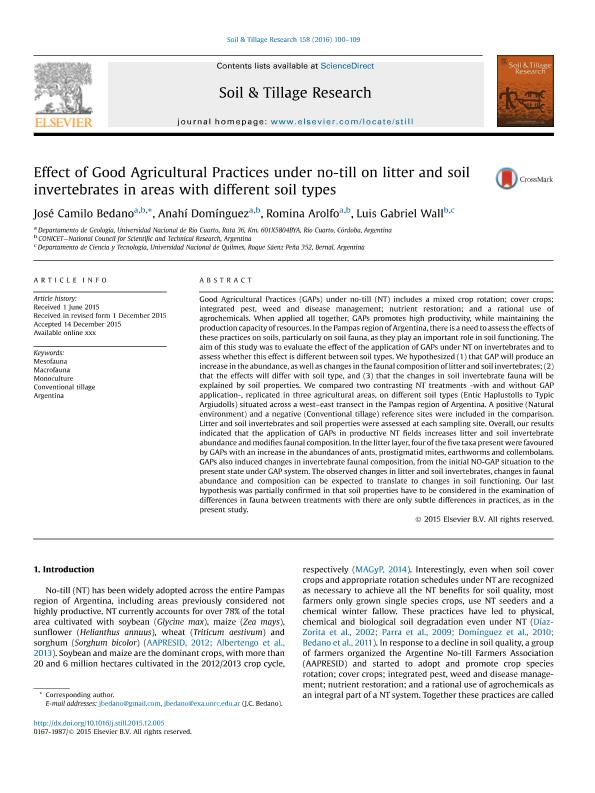Mostrar el registro sencillo del ítem
dc.contributor.author
Bedano, José Camilo

dc.contributor.author
Domínguez, Anahí

dc.contributor.author
Arolfo, Romina Vanesa

dc.contributor.author
Wall, Luis Gabriel

dc.date.available
2020-09-09T12:49:56Z
dc.date.issued
2016-01
dc.identifier.citation
Bedano, José Camilo; Domínguez, Anahí; Arolfo, Romina Vanesa; Wall, Luis Gabriel; Effect of Good Agricultural Practices under no-till on litter and soil invertebrates in areas with different soil types; Elsevier Science; Soil & Tillage Research; 158; 1-2016; 100-109
dc.identifier.issn
0167-1987
dc.identifier.uri
http://hdl.handle.net/11336/113610
dc.description.abstract
Good Agricultural Practices (GAPs) under no-till (NT) includes a mixed crop rotation; cover crops; integrated pest, weed and disease management; nutrient restoration; and a rational use ofagrochemicals. When applied all together, GAPs promotes high productivity, while maintaining theproduction capacity of resources. In the Pampas region of Argentina, there is a need to assess the effects of these practices on soils, particularly on soil fauna, as they play an important role in soil functioning. The aim of this study was to evaluate the effect of the application of GAPs under NT on invertebrates and to assess whether this effect is different between soil types. We hypothesized (1) that GAP will produce an increase in the abundance, as well as changes in the faunal composition of litter and soil invertebrates; (2) that the effects will differ with soil type, and (3) that the changes in soil invertebrate fauna will be explained by soil properties. We compared two contrasting NT treatments -with and without GAP application-, replicated in three agricultural areas, on different soil types (Entic Haplustolls to Typic Argiudolls) situated across a west?east transect in the Pampas region of Argentina. A positive (Natural environment) and a negative (Conventional tillage) reference sites were included in the comparison. Litter and soil invertebrates and soil properties were assessed at each sampling site. Overall, our results indicated that the application of GAPs in productive NT fields increases litter and soil invertebrate abundance and modifies faunal composition. In the litter layer, four of the five taxa present were favouredby GAPs with an increase in the abundances of ants, prostigmatid mites, earthworms and collembolans. GAPs also induced changes in invertebrate faunal composition, from the initial NO-GAP situation to the present state under GAP system. The observed changes in litter and soil invertebrates, changes in faunal abundance and composition can be expected to translate to changes in soil functioning. Our last hypothesis was partially confirmed in that soil properties have to be considered in the examination of differences in fauna between treatments with there are only subtle differences in practices, as in the present study
dc.format
application/pdf
dc.language.iso
eng
dc.publisher
Elsevier Science

dc.rights
info:eu-repo/semantics/openAccess
dc.rights.uri
https://creativecommons.org/licenses/by-nc-sa/2.5/ar/
dc.subject
MESOFAUNA
dc.subject
MACROFAUNA
dc.subject
MONOCULTURE
dc.subject
CONVENTIONAL TILLAGE
dc.subject
ARGENTINA
dc.subject.classification
Conservación de la Biodiversidad

dc.subject.classification
Ciencias Biológicas

dc.subject.classification
CIENCIAS NATURALES Y EXACTAS

dc.title
Effect of Good Agricultural Practices under no-till on litter and soil invertebrates in areas with different soil types
dc.type
info:eu-repo/semantics/article
dc.type
info:ar-repo/semantics/artículo
dc.type
info:eu-repo/semantics/publishedVersion
dc.date.updated
2020-09-08T19:54:59Z
dc.journal.volume
158
dc.journal.pagination
100-109
dc.journal.pais
Países Bajos

dc.journal.ciudad
Amsterdam
dc.description.fil
Fil: Bedano, José Camilo. Universidad Nacional de Río Cuarto. Facultad de Ciencias Exactas, Fisicoquímicas y Naturales. Departamento de Geología; Argentina. Consejo Nacional de Investigaciones Científicas y Técnicas; Argentina
dc.description.fil
Fil: Domínguez, Anahí. Universidad Nacional de Río Cuarto. Facultad de Ciencias Exactas, Fisicoquímicas y Naturales. Departamento de Geología; Argentina. Consejo Nacional de Investigaciones Científicas y Técnicas; Argentina
dc.description.fil
Fil: Arolfo, Romina Vanesa. Consejo Nacional de Investigaciones Científicas y Técnicas; Argentina. Universidad Nacional de Río Cuarto. Facultad de Ciencias Exactas, Fisicoquímicas y Naturales. Departamento de Geología; Argentina
dc.description.fil
Fil: Wall, Luis Gabriel. Consejo Nacional de Investigaciones Científicas y Técnicas; Argentina. Universidad Nacional de Quilmes. Departamento de Ciencia y Tecnología; Argentina
dc.journal.title
Soil & Tillage Research

dc.relation.alternativeid
info:eu-repo/semantics/altIdentifier/doi/http://dx.doi.org/10.1016/j.still.2015.12.005
dc.relation.alternativeid
info:eu-repo/semantics/altIdentifier/url/https://www.sciencedirect.com/science/article/pii/S0167198715300702
Archivos asociados
